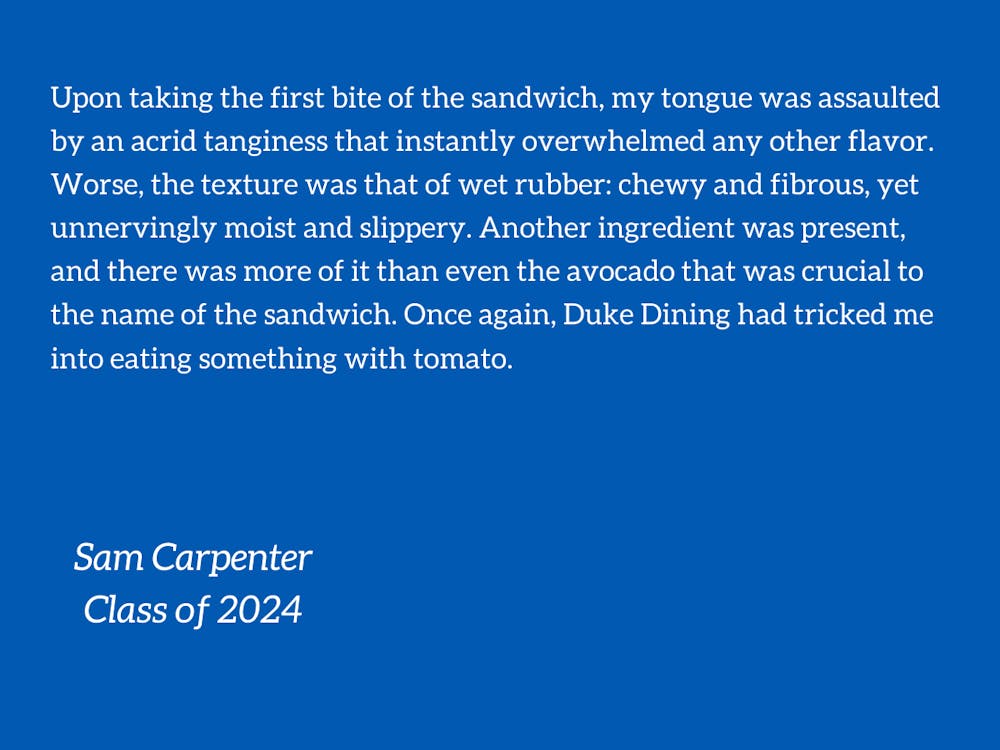Last week, I went to Twinnie’s, the beloved cafe in the engineering quad, to get a sandwich. As I surveyed their ample selection, one candidate caught my eye: the Turkey Avocado Mayo Bacon sandwich. Its candor both surprised and intrigued me. The name listed every single item on it and absolutely nothing else; this was a sandwich for the student on-the-go, who wanted a no-nonsense lunch that was both delicious and nutritious. This was a sandwich for the student who wanted their food to be honest, and who derived immense satisfaction from taking a simple yet effective approach to dining. This was the sandwich for me. Out of both hunger and respect, I ordered one and waited.
But I was deceived.
Upon taking the first bite of the sandwich, my tongue was assaulted by an acrid tanginess that instantly overwhelmed any other flavor. Worse, the texture was that of wet rubber: chewy and fibrous, yet unnervingly moist and slippery. Another ingredient was present, and there was more of it than even the avocado that was crucial to the name of the sandwich. Once again, Duke Dining had tricked me into eating something with tomato.
Let’s step back for a moment and examine the tomato as a fruit. The taste of a tomato is pretty good, even if it’s strong. It’s sweet, tangy, just a little bit acidic and surprisingly savory; not my favorite, but I can understand why others enjoy it. The texture is more of a mixed bag, with some parts that are relatively rubbery and an uncomfortable amount of juiciness, but it too has its time and place. Even if my personal preferences are against this particular fruit, it does have some value to it.
Unfortunately, tomato is often forced well outside of its appropriate context. The taste can be very overwhelming; imagine putting even a small amount of ketchup on mac and cheese! Even more so, the texture only works in a very few settings; this is why many iconic tomato dishes like pizza and salsa use tomato sauce or crushed/chopped tomatoes, rather than the wet rubber composite that defines a whole tomato. This may seem obvious, but Duke Dining apparently has taken a different approach, choosing not to carefully place tomatoes on the appropriate meals but instead to slap some slices onto sandwiches of every sort.
It’s a mistake they make frequently, at a variety of venues. Obviously, Twinnie’s has snuck tomatoes into many innocent-looking meals, but nearly every sandwich offering at CaFe includes tomatoes; and so do many of the crepes! Almost every bread-bound bite to eat at Pitchfork’s comes with tomato on it, from the burger and the fried chicken sandwich to the moderately more appropriate salsa on tacos. Even beloved campus eatery The Loop slaps slices onto most of their dishes. This isn’t to say that no sandwiches should have tomatoes on them; far from it, in fact. Many sandwiches need a tomato, from lots of classic burgers to club sandwiches. However, the tomato is not meant to be an all-purpose topping, and it is a major mistake to use it as such.
Consider, for a moment, the elegant lettuce. The texture of lettuce is light and crispy, elevating the mouthfeel of a sandwich but not dominating it. The flavor is light and watery, yet refreshing, adding a dimension without bringing down any others. The lettuce is the superior version of a tomato, actually valid as a semi-universal topping, and yet it is present on fewer sandwiches than the tomato. Duke Dining, there is no excuse for so many campus sandwiches to default to the tomato. It is time to release the sandwich from its slimy bonds, and allow me to finally order lunch without telling the person at the counter to remove the tomatoes.
Sam Carpenter is a Trinity sophomore. His column typically runs on alternate Fridays.
Get The Chronicle straight to your inbox
Signup for our weekly newsletter. Cancel at any time.

